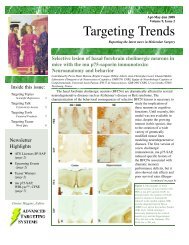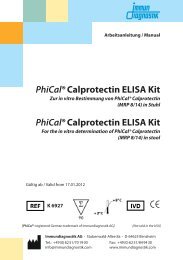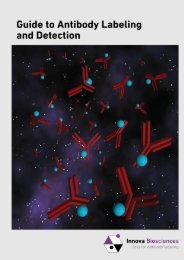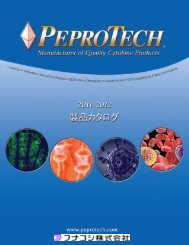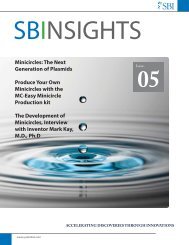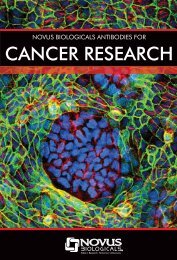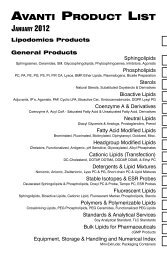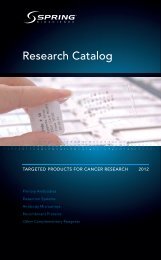Thermo Scientific Pierce Crosslinking Technical Handbook
Thermo Scientific Pierce Crosslinking Technical Handbook
Thermo Scientific Pierce Crosslinking Technical Handbook
You also want an ePaper? Increase the reach of your titles
YUMPU automatically turns print PDFs into web optimized ePapers that Google loves.
Single-step vs. Multi-step Reactions<br />
In sequential procedures, heterobifunctional reagents are reacted<br />
with one protein using the most labile group of the crosslinker first.<br />
After removing excess unreacted crosslinker, the modified first<br />
protein is added to a solution containing the second protein where<br />
reaction through the second reactive group of the crosslinker<br />
occurs. The most widely used heterobifunctional crosslinkers<br />
are those having an amine-reactive succinimidyl ester (e.g.,<br />
NHS-ester) at one end and a sulfhydryl-reactive group on the<br />
other end. The sulfhydryl-reactive groups are usually maleimides,<br />
pyridyl disulfides and α-haloacetyls. The NHS-ester reactivity<br />
is less stable in aqueous solution and is usually reacted first in<br />
sequential crosslinking procedures. NHS-esters react with amines<br />
to form amide bonds. Carbodiimides are zero-length crosslinkers<br />
(e.g., EDC, Product # 22980, 22981) and effect direct coupling<br />
between carboxylates (–COOH) and primary amines (–NH 2 ) and<br />
have been used in peptide synthesis, hapten-carrier protein<br />
conjugation, subunit studies and protein:protein conjugation.<br />
Homo- and heterobifunctional crosslinkers<br />
Crosslinkers can be either homobifunctional or heterobifunctional.<br />
Homobifunctional crosslinkers have two identical reactive groups<br />
and often are used in one-step reaction procedures to crosslink<br />
proteins, to each other or to stabilize quaternary structure, in<br />
solution. Even when conjugation of two different proteins is the<br />
goal, one-step crosslinking with homobifunctional reagents often<br />
results in self-conjugation, intramolecular crosslinking and/or<br />
polymerization.<br />
Other heterobifunctional reagents have one reactive group that<br />
is photoreactive rather than thermoreactive. These have distinct<br />
advantages in protein:protein interaction studies and in cases<br />
in which the availability of thermoreactive targetable functional<br />
groups is unknown. This reactivity allows for specific attachment<br />
of the labile thermoreactive group first; subsequently, conjugation<br />
to any adjacent N-H or C-H sites may be initiated through the<br />
photoreactive group by activation with UV light.<br />
The reactivity of the photochemical reagent allows for formation<br />
of a conjugate that may not be possible with a group-specific<br />
reagent. The efficiency of most photoreactive crosslinkers is low,<br />
and yields of 10% are considered acceptable. However, SFAD<br />
(Product # 27719) is a photoactivatable reagent that contains a<br />
perfluorophenyl azide with an insertion efficiency of 70%.<br />
Heterobifunctional crosslinkers possess two different reactive<br />
groups that allow for sequential (two-stage) conjugations,<br />
helping to minimize undesirable polymerization or self-conjugation.<br />
Heterobifunctional reagents can be used when modification of<br />
amines is problematic. Amines are sometimes present at the active<br />
sites of proteins and modification of these may lead to activity loss.<br />
Other moieties such as sulfhydryls, carboxyls, phenols and carbohydrates<br />
may be more appropriate targets. A two-step strategy<br />
allows a protein that can tolerate the modification of its amines<br />
to be coupled to a protein or other molecule having different<br />
accessible groups. Crosslinkers that are amine-reactive at one<br />
end and sulfhydryl-reactive at the other end are especially useful<br />
in this regard.<br />
14<br />
For more information, or to download product instructions, visit www.thermo.com/pierce



